
Mortellaro's Nursery
Shrubs, trees, ground covers, native plants, and seasonal color
Wholesale Only
Click on any of the alpha indexes below to view the corresponding lists of plants.
The default list is displayed alphabetically by common name for all plant types. You can view the plants by clicking on the Scientific Name or limit the plant type by using the drop down.
Plants actively being grown for the current season are shown -- selecting Discontinued Items will show plants we have offered in the past.
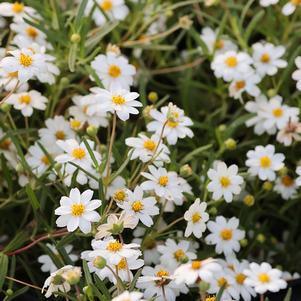
|
Daisy, Black FootBotanical Name: Melampodium leucanthum
Blackfoot Daisy is a Texas native perennial beloved for its hardiness and abundant blooms. This low-growing, mounding plant reaches a mature height of 8 to 12 inches and spreads 12 to 18 inches, making it an excellent choice for borders, rock gardens, or mass plantings. It thrives in full sun and well-drained, rocky, or sandy soils, perfectly adapted to the arid and semi-arid regions of Texas, including West Texas. Blackfoot Daisy performs best in USDA Zones 5 through 10 and is highly heat- and drought-tolerant once established. This perennial shines in the landscape with its small, daisy-like white flowers featuring yellow centers, blooming prolifically from spring through fall. Its compact size and ability to thrive in poor soils make it ideal for xeriscaping or as a groundcover in sunny areas. It is deer-resistant and attracts pollinators, such as bees and butterflies, further adding to its value in Texas gardens. However, it may not perform as well in areas with high humidity or heavy clay soils that retain moisture. While Blackfoot Daisy is non-toxic, it’s worth noting that its sap can occasionally irritate sensitive skin. It prefers slightly alkaline to neutral soils and requires excellent drainage to avoid root rot. When planting multiple Blackfoot Daisies, space them about 12 to 18 inches apart to allow for their natural spread and to ensure good airflow, which helps prevent fungal issues. Its ability to withstand intense Texas heat makes it an enduring favorite for sunny, dry landscapes. In winter, Blackfoot Daisy can tolerate light frosts but may struggle in areas with prolonged freezes. Mulching around the base can help protect its roots during colder months. If the plant dies back in winter, it often returns from the roots in spring when the weather warms. [ More Info ]
|
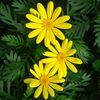
|
Daisy, BushBotanical Name: Gamolepis chrysanthemoides
Bush Daisy is a cheerful, evergreen shrub-like perennial known for its bright yellow blooms and fine, dark green foliage. It typically grows to a mature height and width of 2 to 3 feet, forming a neat, rounded shape. It thrives in full sun and well-drained soil, making it a great addition to many Texas landscapes, thriving in Central and South Texas. While it tolerates brief drought periods, regular watering is necessary for optimal blooming. This versatile plant is perfect for mass plantings, borders, or containers, providing a consistent pop of color almost year-round in warmer climates. The showy yellow flowers attract pollinators such as bees and butterflies, adding life to the garden. Bush Daisy performs best in acidic areas with good drainage and may struggle in heavy clay or poorly draining soils. Though it is deer-tolerant, some grazing may occur during periods of low food availability. Bush Daisy is non-toxic but should be handled with care, as its sap may irritate sensitive skin. It prefers slightly acidic to neutral soils and appreciates protection from intense afternoon heat, especially in areas with brutal Texas summers. When planting multiple Bush Daisies, space them 2 to 3 feet apart to allow for airflow and their mature size. Their compact form and profuse blooming make them excellent for flower gardens or mixed perennial beds. In winter, Bush Daisy may be damaged by severe freezes but often returns from the roots in spring if protected. Adding mulch around the base of the plant can help insulate the roots during colder months. Prune back any frost-damaged growth in early spring to encourage its return. [ More Info ]
|
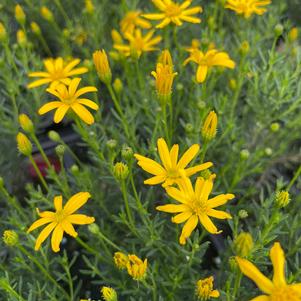
|
DamianitaBotanical Name: Chrysactinia mexicana
Chrysactinia mexicana, also known as Damianita or False Damiana, is a charming and resilient perennial shrub native to the southwestern United States and northern Mexico. With its small, evergreen leaves and abundant clusters of daisy-like golden-yellow flowers, it brings a burst of color and cheer to arid landscapes. Its compact growth habit, reaching no more than 2 feet in height and spread, makes it well-suited for borders, rock gardens, and containers, adding a touch of brightness to even the smallest spaces. This drought-tolerant and heat-loving plant thrives in full sun and well-drained soil, making it an ideal choice for xeriscaping projects or water-wise gardens. Its aromatic foliage releases a pleasant fragrance when brushed against, further enhancing its appeal in the landscape. Additionally, Chrysactinia mexicana attracts pollinators like bees and butterflies, contributing to the biodiversity of the garden ecosystem. The fragrance also deters deer from consuming it. Low-maintenance and resilient, Damianita requires little care once established, thriving in hot, dry conditions without the need for frequent watering or fertilization. Pruning after flowering helps maintain its compact shape and encourages continued blooming. [ More Info ]
|
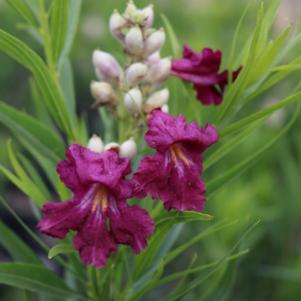
|
Desert Willow, 'Sweet Bubba'Botanical Name: Chilopsis linearis 'Sweet Bubba'
'Sweet Bubba' is a cultivated variety of the Chilopsis linearis plant, commonly known as desert willow. The 'Sweet Bubba' cultivar is primarily known for its ornamental value. It features attractive, trumpet-shaped flowers that bloom during the summer months, creating a stunning display of color. The flowers of 'Sweet Bubba' are dark burgundy, and are quite abundant and appear in clusters, adding a vibrant touch to any landscape. Easily attracts pollinators such as hummingbirds and bees. In addition to its beautiful flowers, 'Sweet Bubba' also possesses slender, willow-like leaves that are green and elongated. These leaves add an elegant and graceful element to the tree's overall appearance. During the autumn season, the foliage of 'Sweet Bubba' turns yellow, providing a final burst of color before the leaves drop. One of the notable attributes of Desert Willow is its adaptability to various growing conditions. It is particularly well-suited for arid and semi-arid regions, thriving in dry, desert-like environments. This makes it a popular choice for gardens and landscapes in many areas of Texas. It prefers well-drained soil and full sun exposure for optimal growth and flowering. While it can tolerate a range of soil types, it thrives in sandy or loamy soils. [ More Info ]
|
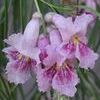
|
Desert Willow, LavenderBotanical Name: Chilopsis linearis
A tough and durable Texas native tree from west Texas that fits in nearly any Texas landscape. It is not a true willow --its name from the graceful, green narrow leaves. Flowers emerge in terminal clusters starting in the spring on new branches, and continue to appear until fall. Butterflies and hummingbirds are easily attracted to the slightly fragrant, bell funnel-shaped shaped flowers. Colors range from light pink to light violet, with variations in white and burgundy. Long slender seed capsules persist in the winter after the leaves have already fallen; opening slowly to release fluffy, winged seeds that can get carried a fair distance in the wind. Desert Willow is fast growing, tolerant of hot and dry conditions, and relatively pest and disease free. Regular fertilization and watering results in a quick growing shade tree that will fill an empty space in any landscape. [ More Info ]
|
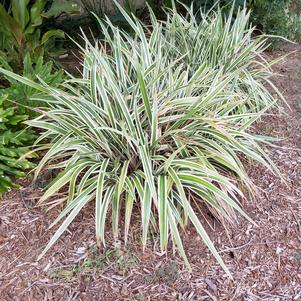
|
Dianella, Variegated Flax LilyBotanical Name: Dianella tasmanica 'Variegata'
Dianella tasmanica 'Variegata,' commonly known as Variegated Flax Lily, is an eye-catching, evergreen perennial ideal for Texas landscapes due to its adaptability and striking appearance. This plant is prized for its long, sword-shaped leaves adorned with creamy white margins, adding texture and brightness to shaded or partially sunny garden areas. It grows in clumps that reach about 1.5 to 2 feet in height and spread, making it a great choice for borders, mass plantings, or as a specimen plant in containers. In addition to its striking foliage, 'Variegata' produces small, star-shaped blue flowers on tall stems in spring, followed by ornamental, metallic-blue berries in summer. While the flowers are subtle, the berries add seasonal interest and contrast to the plant’s variegated leaves. It performs best in well-drained soils and thrives in partial shade. Although it is moderately drought-tolerant, it benefits from supplemental water during extended dry periods. In regions with hard freezes, the plant may die back to the ground, but it slowly recovers and regrows from the roots as temperatures return in the summer. Low-maintenance and resilient, Dianella tasmanica 'Variegata' is a perfect addition to water-wise or low-maintenance landscapes. It requires minimal pruning and thrives with occasional deep watering once established. The plant’s ability to tolerate a variety of soil types, combined with its deer resistance and ability to recover after freezes, ensures it is well-suited for Texas gardens looking to combine functionality and aesthetic charm. [ More Info ]
|
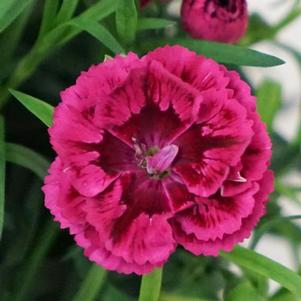
|
DianthusBotanical Name: Dianthus caryophyllus 'DiaDeur™ Pink+Red Dianthus'
DiaDuer Pink & Red Dianthus from Ball Seed is a remarkable variety of the Dianthus family, known for its ability to withstand cold temperatures down to 10 degrees Fahrenheit. This cold-hardy plant not only adds beauty to your garden but also attracts essential pollinators like bees and butterflies, contributing to the local ecosystem. To ensure its health and vibrancy, regular fertilization is recommended. This Dianthus variety favors morning sun and afternoon dappled shade. Its striking multicolored blooms, combining vivid red and pink hues, make it an eye-catching addition to gardens and containers. With a mature size of 14" by 12", it's a perfect fit for container gardening and small spaces. Furthermore, its versatility extends to indoor cultivation, allowing you to bring it inside during freezing weather, providing a practical solution for the unpredictability of our Texas climate.
[ More Info ]
|
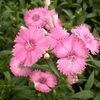
|
DianthusBotanical Name: Dianthus chinensis
Easy annual that does well in hot weather. Stiff upright stems that branch repeatedly, topped with flat clusters of single or double flowers in red, pink, white, or bicolors. No maintenance needed. [ More Info ]
|
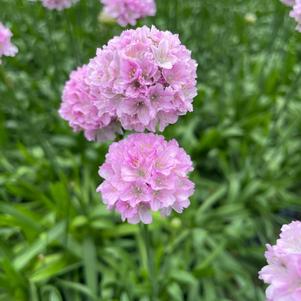
|
Dreameria Sweet Dreams ThriftBotanical Name: Armeria pseudarmeria 'Sweet Dreams'
Compact perennial with tidy growth habit and eye catching flowers on stems that reach above the plant. Easily attracts butterflies and shows tolerance to deer, heat, and light frost. Will bloom early spring to frost and ideal for small flower beds or container plantings. Performs best when old flowers are trimmed off, which is simple due to the tall stems that reach above the foliage. Performs best in a sunny location with well drained soils. Avoid overwatering. [ More Info ]
|
